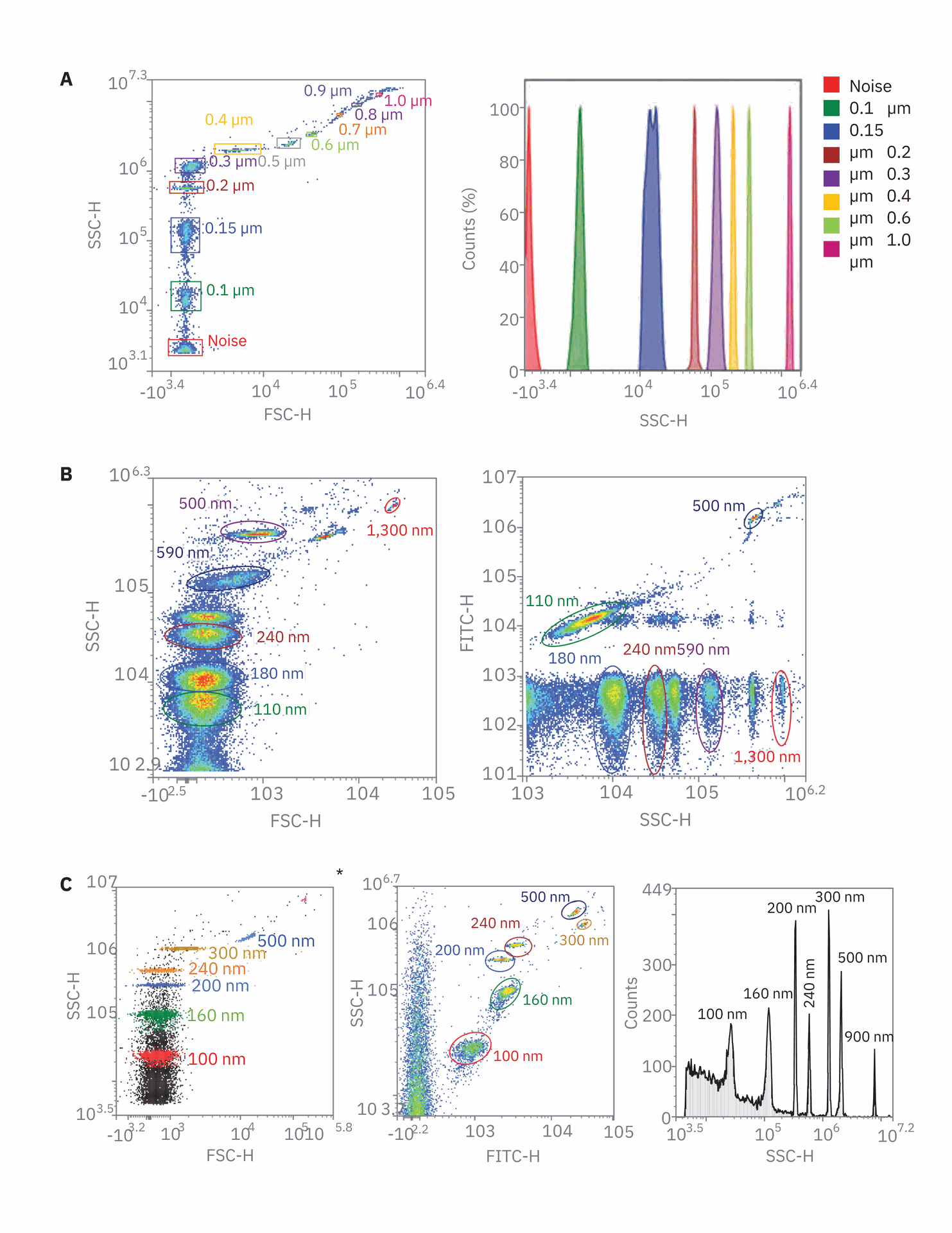High Snsitivity SSC and Fluorescence Detection using the Novocyte Advanteon flow cytometer
Abstract
This Application Note describes the ability of the Agilent NovoCyte Advanteon flow cytometer to resolve small particles, including cell-derived extracellular vesicles (EVs) and beads. The NovoCyte Advanteon, equipped with advanced detectors, provides high sensitivity side-scatter (SSC) and fluorescence detection to give superior results to those of traditional flow cytometers.
Authors
Lauren Jachimowicz, Yan Lu, Peifang Ye, and Garret Guenther Agilent Technologies, Inc.
Introduction
The importance of cell-derived EVs is recognized in multiple biological processes, and is a topic of increasing relevance in biomedical research. EVs are cell-derived membranous vesicles released from cells under normal and pathological conditions. This includes exosomes, microvesicles, and apoptotic bodies according to their cellular origin and size. Exosomes are 50 to 150 nm of endocytic origin. Microvesicles bud from the cell surface and range in size from 50 nm to 1 μm, and apoptotic bodies are 0.8 to 5 μm vesicles released from cells undergoing programmed cell death. EVs are important for intracellular communication, and have been found in blood, other biological fluids, and cultured cell supernatant. EVs have been associated with a wide range of conditions including cancer metastasis, blood disorders, cardiovascular disease, infectious disease, and others. The therapeutic potential of EVs as a cell-free treatment for cancer and other pathologies has been investigated extensively. Current EV detection methods use techniques such as western blotting and enzyme-linked immunosorbent assay (ELISA) to determine bulk protein concentration in purified particles, which prevents readout of individual samples. Including flow cytometric assays in small particle research could enhance current detection methods,
with the capability to analyze individual particles in significant numbers and measure surface protein levels. However, traditional flow cytometers have difficulty resolving EVs due to their small diameter and variable composition. Technological advancements in flow cytometry, as with the NovoCyte Advanteon, have increased the capacity to detect small particles, such as EVs. This investigation determines the ability of the NovoCyte Advanteon flow cytometer to resolve small particles using beads and cell-derived EVs.
Experimental
The NovoCyte Advanteon can detect small particle beads with sensitive SSC detection
To determine the capability of the NovoCyte Advanteon to resolve small particles, we first performed an analysis of three commercially available small particle bead mixes:
- Bang’s laboratories NIST-traceable
- size standards
- ApogeeMix beads
- BioCytex-Plus FSC and SSC hybrid
- microspheres
These each consist of beads ranging
in size from 100 to 1,300 nm. Equipped
with an avalanche photodiode for SSC
instead of the traditional photodiode
detector, the NovoCyte Advanteon was
able to resolve beads as small as 100 nm
using SSC alone (Figure 1).
The refractive index (RI) of membrane vesicles is different than particle beads, therefore it is important to determine the capability of the NovoCyte Advanteon to detect biologically derived EVs. We analyzed purified lipoparticles derived from HEK293T green fluorescent protein (GFP) expressing cells, the release of which is induced by Murine leukemia virus (MLV). These lipoparticles are approximately 240 nm determined by dynamic light scattering (Figure 2A). Lipoparticles were separated from the background (Figure 2B) by SSC as well as GFP fluorescence. In addition, the NovoCyte Advanteon features a syringe pump precisely measuring sample volumes, allowing direct absolute counting of lipoparticles. Figure 2C shows the results of a serial dilution of MLV-induced lipoparticles. With small particle detection, it is important to ensure that single particles are analyzed. If particles are run at too high of a concentration, the particles can be too close together and multiple particles may be detected as a single event. This phenomenon is known as coincidence or the swarm effect. Individual particles that would normally register below the detection threshold are detected as a cumulative event, enabling them to reach the trigger threshold. This effect distorts the data, altering the detected sample concentration and phenotype. One way to control for this is to perform serial dilutions of the sample, to ensure single particle detection. If there is no coincidence, a linear decrease in sample concentration should be observed with serial dilutions. Based on the measured absolute event count, the actual dilution factor correlated well with the calculated dilution factor (Figure 2C), confirming that the events detected were not due to coincidence. These data demonstrate the capacity of the NovoCyte Advanteon to detect small membranous particles.

Figure 1. Small particle bead detection on the Agilent NovoCyte Advanteon. Three commercially available small particle beads were used to demonstrate the high sensitivity of the NovoCyte Advanteon side scatter detection (SSC): Bang’s Laboratories NIST traceable size standards (A), ApogeeMix beads (B), and BioCytex Megamix-Plus (C). Particles as small as 100 nm were easily resolved from the background. Instrument settings: SSC-H gain 1,000, FSC-H gain 1,000, threshold SSC-H greater than 1,000.
